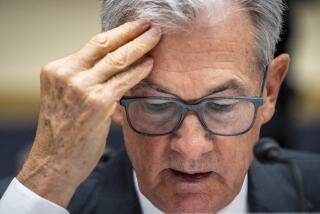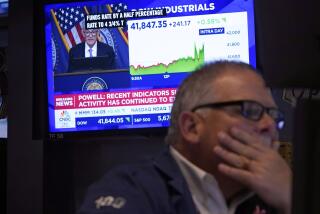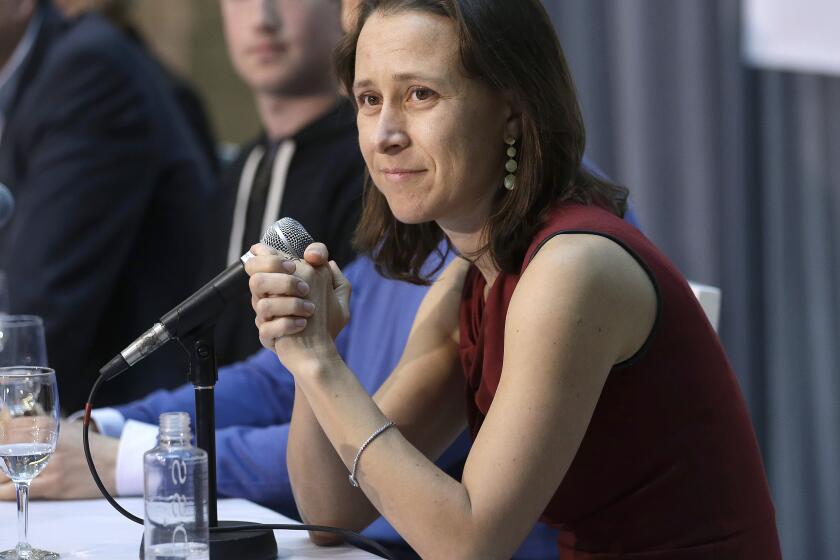Fed Cuts Back Amount Banks Need in Reserve : Policy: Some economists see the move as a subtle and unusual effort by the central bank to influence the flagging economy.
- Share via
The Federal Reserve Board, in an effort to spark new lending and provide a modest lift to the weak U.S. economy, aannounced on Tuesday that it was reducing the amount of money that banks must hold in reserve.
The step, coming on the eve of Fed Chairman Alan Greenspan’s semi-annual report on the economy to Congress, was seen by some economists as a subtle and unusual effort by the central bank to influence the flagging economy.
The new policy is projected to free up $8 billion in cash for lending and investment by banks. It means that banks must hold reserves equal to 10% of their “transaction”--typically checking accounts. Under the old rule, which will expire April 2, banks had to maintain reserves of 12%.
The announcement, which comes amid continuing worries about the economy and banking system, drew a mixed response from the financial world. Some analysts said it would bolster bank profits, while others pointed out that it would have little effect on lending unless more borrowers step forward.
At first, the Dow Jones average of 30 industrial stocks jumped 16 points on the news, but then drifted back down.
“It sounds like half a loaf,” said Gary Schlossberg, an economist at Wells Fargo Bank in San Francisco. “It could help” the economy, he added, especially if the Fed engineers further declines in interest rates.
While the move was seen as largely symbolic, some economists said that the Fed’s action might shave the federal funds rate--the interest banks charge each other for overnight loans. The Fed has targeted the rate at 4%, and it was at 4.25% late Tuesday. But it was doubtful whether consumers would feel much impact from an interest rate drop.
Since the recession began in mid-1990, the Fed has repeatedly used more conventional tools to push the economy, including cuts in the discount rate, which it charges to federal reserve banks, and the federal funds rate, which banks charge each other for overnight loans.
The move shows that “the Federal Reserve is using the entire arsenal of tools at its disposal to encourage economic growth,” said Don Ogilvie, executive vice president of the American Bankers Assn. “These actions result in an increase in the nation’s money supply and a lowering of interest rates so that money can be made available at affordable rates to consumers, small businesses and other borrowers.”
Tuesday’s announcement came on the eve of Fed Chairman Alan Greenspan’s appearance before the House Banking Committee, in which he will provide the central bank’s 1992 economic forecast and give an update on monetary policy.
“The timing is certainly interesting,” Schlossberg said of the announcement. “It could be a way for the Fed to keep critics at arm’s length, while they contemplate policy down the road.”
Greenspan has been criticized for responding too slowly to the economy’s slide into recession in July, 1990. In recent weeks, Greenspan has maintained that the Fed’s sharp reduction in the discount rate in December was sufficient to boost the economy, but said further easing would be taken if necessary.
The Fed said its action Tuesday was the first major change in reserve requirements since Congress approved the Monetary Control Act in 1980. At the end of 1990, the Fed eliminated the reserve requirement on non-personal time deposits and Eurocurrency liabilities.
In a statement, the Fed said its action Tuesday will reduce costs for depositories, strengthening banks’ balance sheets and thus improving their access to capital markets and their ability to offer credit. Over time, most of the cost savings “will be passed on to depositors and borrowers,” the Fed added.
The new policy also could help banks by expanding the amount of money they have to invest rather than hold in vaults, analysts said.
One financial economist described the Fed move as “positive,” but wondered about the significance of more cash for banks to lend--at a time when many institutions say they have a surplus of cash and a shortage of qualified applicants.
“If you give somebody who’s dying of thirst a glass of water, it’s a big deal,” said Martin A. Regalia, director of research and economics at the National Council of Savings Institutions in Washington. “If you give somebody who’s sitting around a pool in Bel-Air a glass of water, he looks at you like you’re crazy.”
More to Read
Inside the business of entertainment
The Wide Shot brings you news, analysis and insights on everything from streaming wars to production — and what it all means for the future.
You may occasionally receive promotional content from the Los Angeles Times.










